How to create custom labels to segment my catalog?
In your ads manager, you can segment your product catalog by creating product sets according to one or several common criteria. This allows you to better control which products will appear in your ads.
You can create product sets by filtering on multiple criteria: category, brand, price, condition, color, etc. But you can also use personal criteria. These are called "custom labels". For example, you can use custom labels to indicate the seasonality of your products (summer, christmas time, valentine's day,...) or their popularity (best sellers, low sales,...), the margin rate applied to these products, etc...
So, thanks to these custom labels, your ad campaigns can be used more wisely to better promote your products on the social network. For example, products belonging to the "Summer products" set are not, in general, distributed during winter.
Example:
- Custom label 0 : "Summer time"
- Custom label 1 : "Best sellers"
- Custom label 2 : "Price under $5"
- Custom label 3 : "High margin"
- Custom label 4 : "New products"
You can assign up to 5 custom labels, numbered 0 through 4, to each product. So, although our module allows you to potentially create as many custom labels as you want, if one of your products has more than 5 custom labels, our module will select only the first 5 ones.
Remember that you are the only one who sees these labels and that they are only intended to help you as a merchant in managing your catalog in your ads manager interface. They don't appear in your ads.
Thanks to our module, you can create advanced custom labels.
To create your custom labels, go to the "Custom labels integration" tab of the module "Advanced data feed options" section and click "Add a custom label":

A pop-up appears to allow you to create your first set of custom labels. Select "Yes" to enable this label set (i.e to include it in your product data to be exported on the social network).
Then the module asks you to choose among 8 ways to configure your labels:
- Basic
- Categories (dynamic mode)
- Features (dynamic mode)
- New product (dynamic mode)
- Best sales (dynamic mode)
- Price Range (dynamic mode)
- Products ordered (dynamic mode)
- Products in promotion (dynamic mode)

Choose a basic configuration to have a maximum freedom in assigning labels. With it, you can write the label's name and then select the category(ies) or brand(s) or supplier(s) of the products you want to assign this label. You can also select one by one some products, by starting to type their names.
Example:

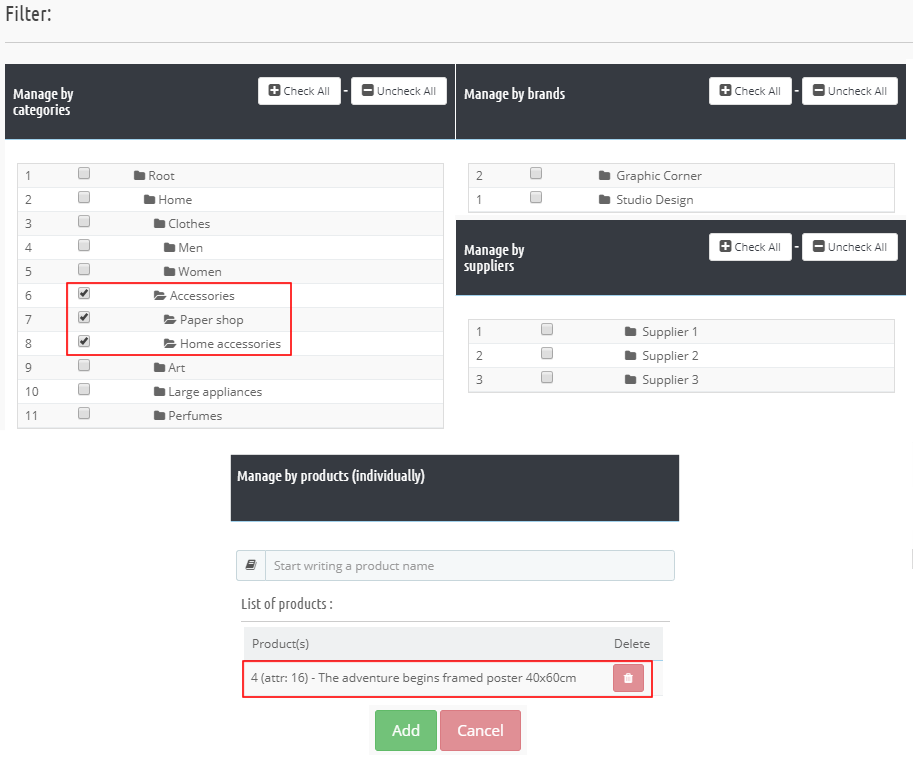
In this example, a custom label "High Margin" has been created to identify the products with the highest margin. The configuration is "manual" and the custom label will be active until August 31, 2019. The (default) categories "Accessories", "Paper shop" and "Home accessories" have been selected to assign this label to the products associated with them. The "40x60cm" combination of the product "The adventure begins framed poster" was also individually selected.
Click on the green "Add" button to see this custom label set in the custom label list :

A line corresponds to a series of labels affixed to a set of products. A green font means that they are activated, this means that each time your catalog is automatically updated in your ads manager, they will be included in the feed. A red one means that they aren't (as for example the "Valentine's day" labels above).
To add a custom label set, click on the "+" button on the top right of the table or again on the green "Add a custom label" button. When the set has been created manually, all the custom labels bear the same name ("High margin" in the case of our example). We will see that for "dynamic mode" configurations, it will not be the case because the label values will be dynamically retrieved.
You can drag and drop the lines to sort the custom label sets, thanks to the little cross at the left of each line.
The dynamic mode indicates that the products corresponding to the criteria indicated for the assignment of the label, will be identified automatically by the module. For example, if you want to assign a label "new" to all products created after March 5th, you will not have to manually select the products that match this criterion, the module will identify them automatically.
Moreover, in some cases, the module will also retrieve the label value to be affixed. For example, if you choose "Categories (dynamic mode)", you will not have to define the label value to be affixed to the products belonging to the selected categories, because it will be retrieved automatically: it will correspond to the name of the default parent category of the product.
Configuration by "Categories (dynamic mode)":
This type of configuration allows you to assign labels to certain products with the name of their main (default) category. Label values are assigned dynamically since the module will automatically enter the name of the product parent category on the label.
The "Value" field corresponds here, not to the label values, but to the title that you want to give to the set of labels you are creating. You can enter any title you want since this is a free field. This title will serve you to find this set among others in the list of custom label sets.
Example:

In this example, we have decided to assign custom labels to french football clubs jerseys, in order to indicate which club they belong. This could be usefull to create campaigns based only on a single club (PSG for example). We have called this football clubs label set : "Jerseys: french football clubs".
We have selected the "PSG", "OM", "OL", "OGC Nice" and "AS Monaco" categories. So, products of the "PSG" category will have a custom label "PSG", those of the "OM" category will have a "OM" one, and so on. These labels will be valid until the date : 2019/12/31.
Thanks to these labels, we can subdivide the products and create campaigns more targeted.
In the same way, we could create a label set called "Jerseys: football national teams" in order to assign, to each national team jersey, the name of the country they represent. In this way, we could create campaigns only based on France team jerseys for example.
The separate creation of the "Jerseys: french football clubs" and "Jerseys: football national teams" label sets allows to manage them independently (activation/deactivation, expiration date, etc...).
The "Jerseys: french football clubs" and "Jerseys: football national teams" titles allows you to find them in the custom label list (see table below). In the example below, french football clubs jerseys labels are activated (and will therefore be included in the next feed updating), contrary to the football national teams ones :
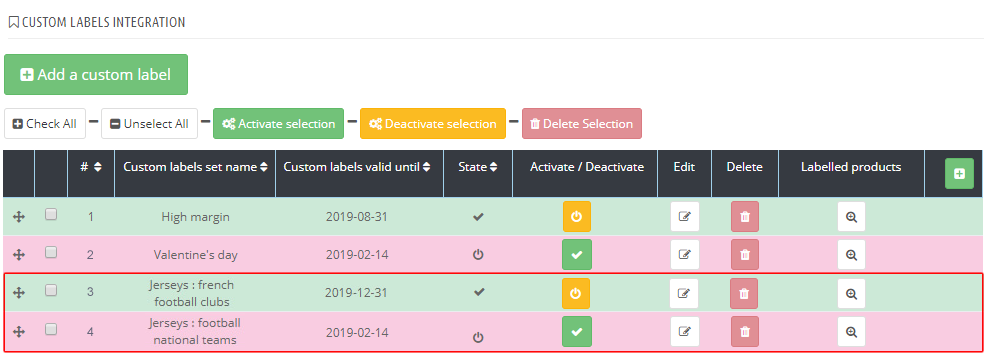
Note : You can drag and drop the lines to sort the custom label sets, thanks to the little cross at the left of each line.
Configuration by "Features (dynamic mode)":
With this type of configuration, you can assign labels to some products with the value of a selected feature. Label values are assigned dynamically since the module will automatically enter the value (if it exists) of the feature assigned to the product on the label.The "Value" field corresponds here to the title that you want to give to the set of labels you are creating. You can enter the title you want since it's a free field. This can be for example the name of the selected feature. This title will serve you to find this set among others in the list of custom label sets.
Example:
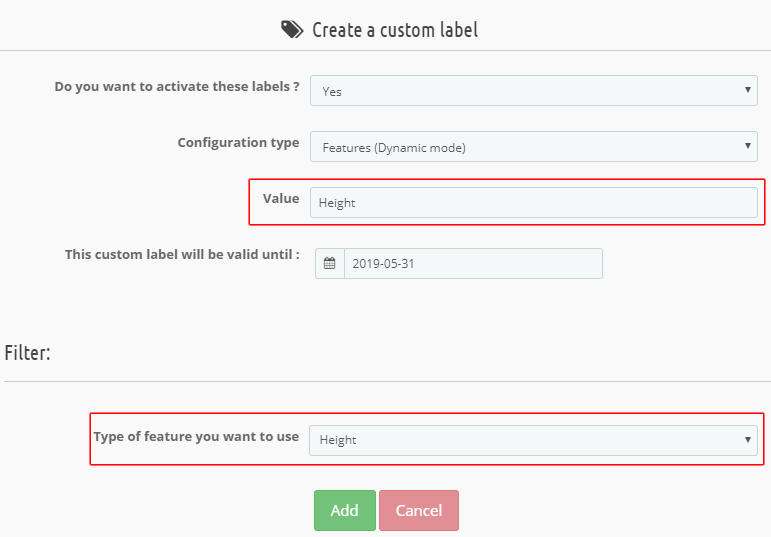
In this example, all the products that have an information about their height will have a label indicating the value of this heigh, and this, until the date : 2019/05/31. Thus, if you have entered the values : "10 cm", "20 cm" and "30 cm" for example for the feature "Height", each product will have, according to its height, either the "10 cm", or the "20 cm" or the "30 cm" label. You will be able then to create ad campaigns based only on a specific height.
You find this label set about the height of the products, in the custom label list :
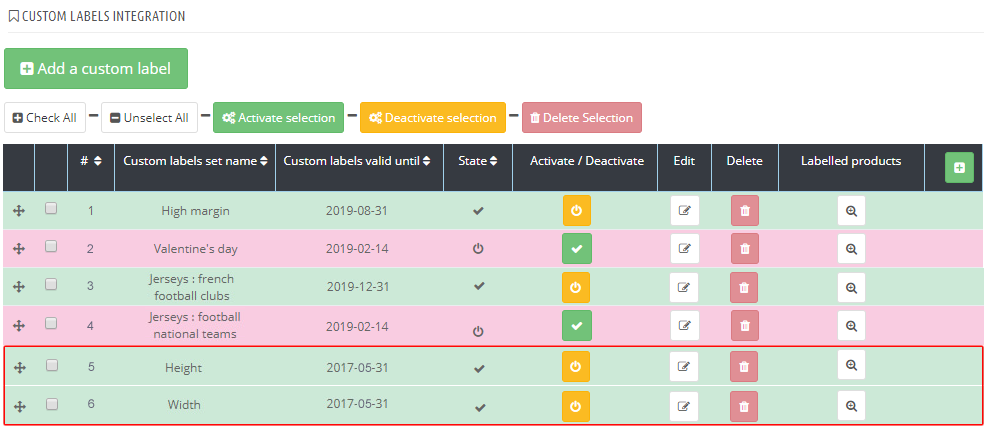
In this example, you can see, just under the label set about the height, that another custom label set from another feature has been created: it's about the products width.
You can drag and drop the lines to sort the custom label sets, thanks to the little cross at the left of each line.
Configuration by "New product (dynamic mode)":
In this type of configuration, you have to indicate the date from which you want that all the added products are considered as "New". The module will then assign a label to all products added to your shop after this date and that belong to the selected categories/brands/suppliers. You can decide of the value of the label in the "Value" field. You can write for example "New product", or something else since the field is free.Example:
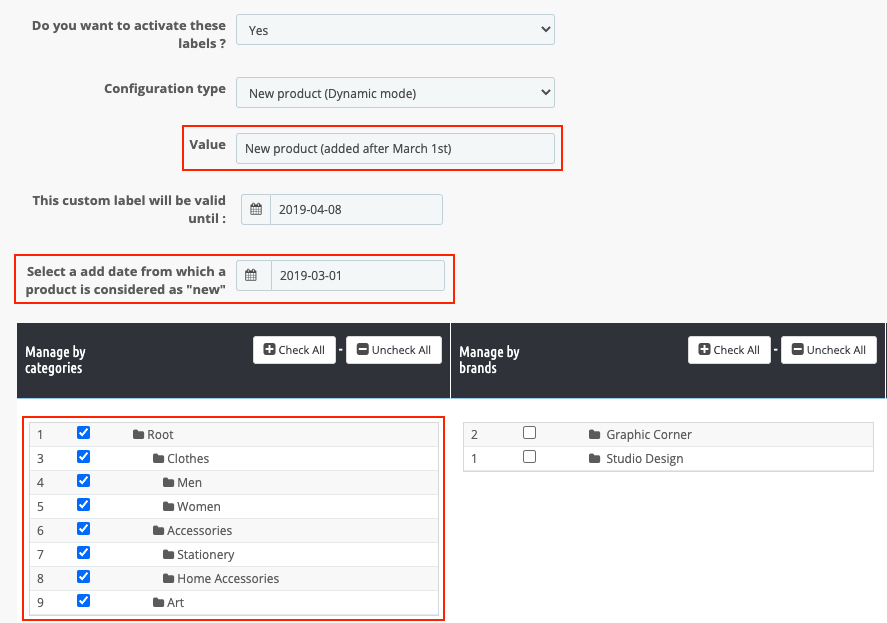
In this example, all the products (because all the categories have been checked) that have been added after the date 2019/03/01 will have a label "New product (added after March 1st)" and this, until the 2019/04/08.
You find then this label set about the new products in the custom label list:
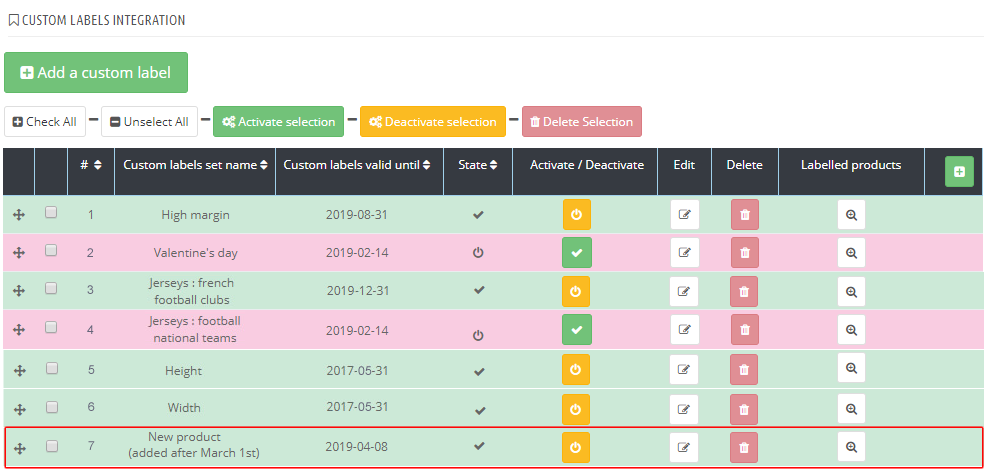
You can drag and drop the lines to sort the custom label sets, thanks to the little cross at the left of each line.
Configuration by "Best sales (dynamic mode)":
In this type of configuration, you have to specify the number of items sold / the generated revenue from which you consider a product is a "best seller". The module will then assign a label to all products that meet this requirement. You can define the value of the label in the "Value" field. It can be simply "Best Seller" but you can write whatever you want since the field is free.
You can, at your choice, define your best sales either in relation to the number of items of the same product sold, or in relation to the revenue generated by this product.
Example:
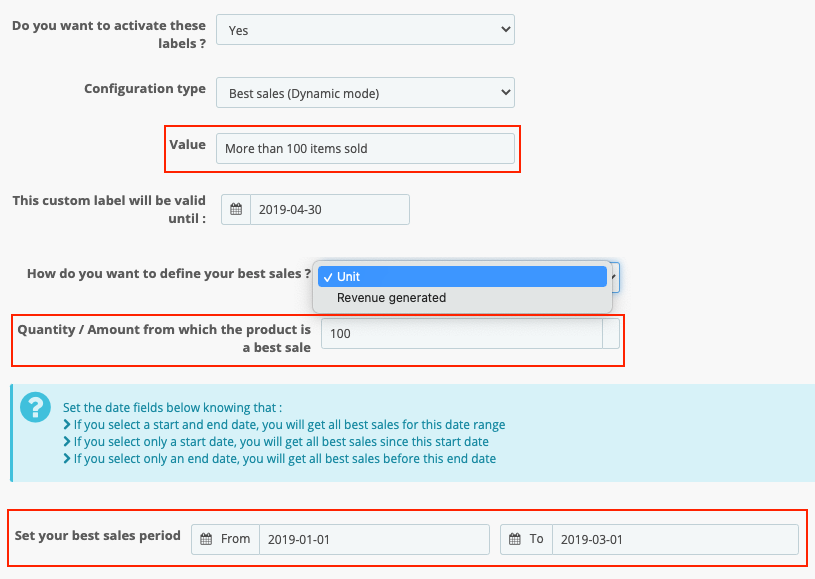
In this example, all the products sold more than 100 times between the 2019/01/01 and the 2019/03/01, will have a label "More than 100 items sold" and this until the 2019/04/30. You could also have defined the best sales in relation to the revenue generated.
Then, you find your label set about best sales in the custom label list :
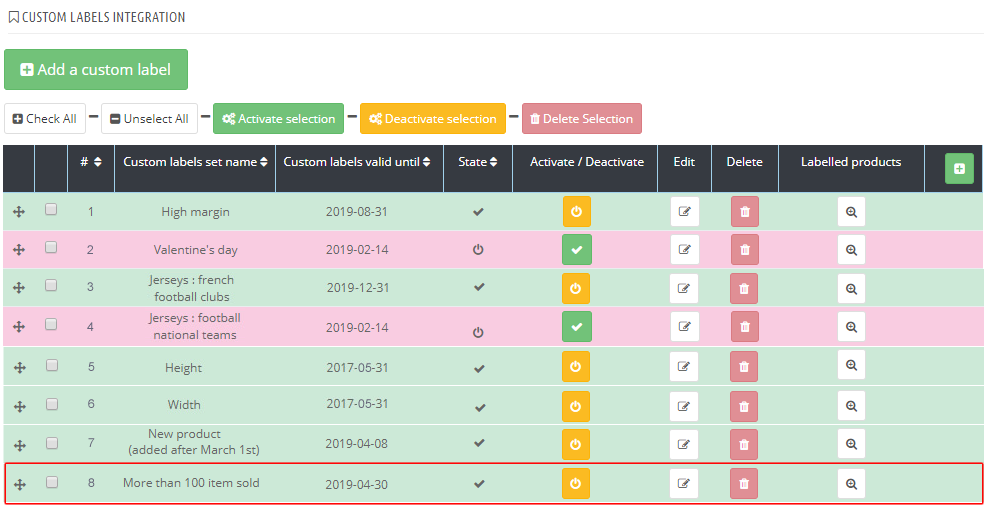
You can drag and drop the lines to sort the custom label sets, thanks to the little cross at the left of each line.
Configuration by "Price range (dynamic mode)":
In this configuration type, you can assign a label to products whose price (excluding tax) is within a price range to be specified. You define the value of the label in the "Value" field. You can indicate in this title the price range concerned or anything else, the field is free.
Example:
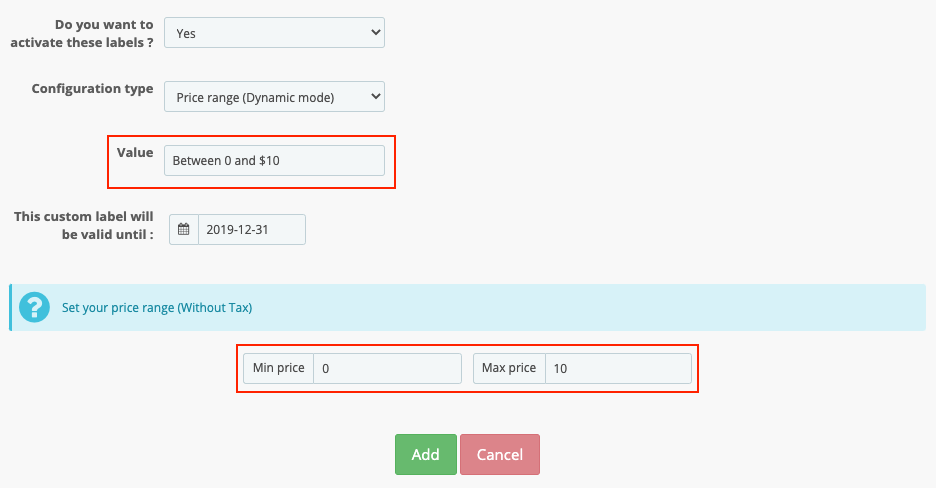
In this example, all the products whose price is between 0 and $10 (tax exluded) will have a label "Between 0 and $10" and this until the 2019/12/31.
You find then this "price range" label set in the custom label list:
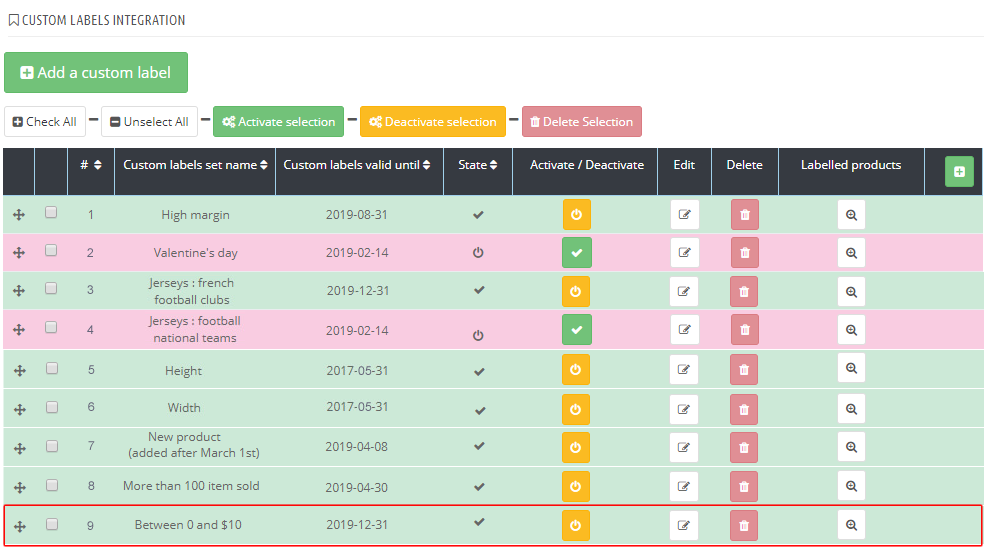
You can drag and drop the lines to sort the custom label sets, thanks to the little cross at the left of each line.
Configuration by "Products ordered (dynamic mode)":
In this type of configuration, you can assign a label to products that have been ordered over a certain period of time in your store. You define the value of the label in the "Value" field. You can indicate the period of orders considered for example, or anything else, the field is free.
Example:
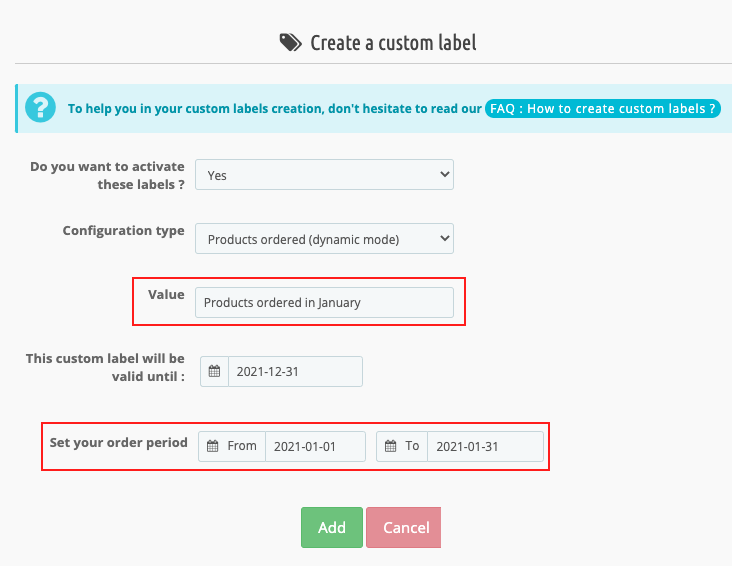
In this example, all products sold between January 1 and 31, 2021, will have a "Products ordered in January" label until December 31, 2021.
You find your set of labels on the products ordered over a certain period, in the list of your custom labels:

You can drag and drop the lines to sort the custom label sets, thanks to the little cross at the left of each line.
Configuration by "Products in promotion (dynamic mode)":
In this type of configuration, you can assign a label to products that are currently in promotion. You define the value of the label in the "Value" field. You can indicate "promo" or what you want, the field is free. The module will automatically assign this label to all products in promotion when the feed is updated.
Example:
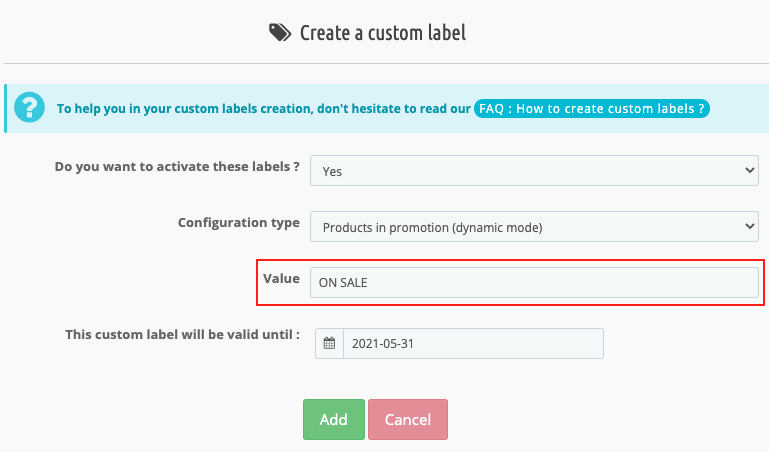
In this example, all the products in promotion at the time of the update of the feed, will have a label "ON SALE" and this, until May 31, 2021.
You find your set of labels on the products in promotion, in the list of your custom labels:

You can drag and drop the lines to sort the custom label sets, thanks to the little cross at the left of each line.
Other FAQs in this category
- Where to find my Business ID?
- How to create and install my Facebook Pixel?
- How to configure the module ?
- How to fill my shop's URL?
- What is the Conversions API and how to enable it in the module?
- How to automatically update my feeds (on-the-fly output or CRON task)?
- Do I have to ask the module to include the attribute IDs into combination URLs?
- How to choose the construction mode of product IDs in the feed?
- How to match my products with Facebook categories?
- How to create advanced exclusion rules?
- Do I need to rewrite numeric values into the combination URLs?
- My shop uses multi-currency : how to make Facebook detect the correct currency?
- Do I have to include the LANG ID in the product ID?
- How to test my Pixel code?
- Should I include anchors in my product URLs?
- What is the Facebook "Advanced Matching" feature?
- I manage several languages/countries/currencies: How to use Facebook country feeds?
- How to tag products reserved for adults?